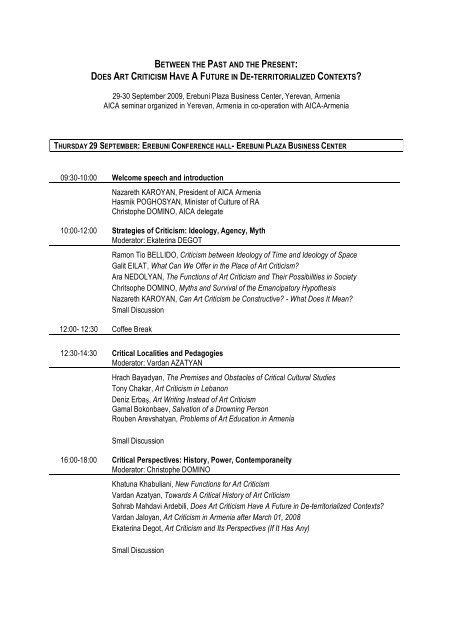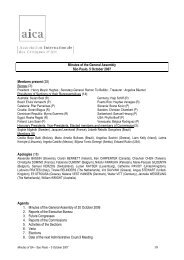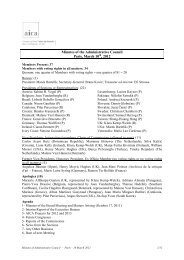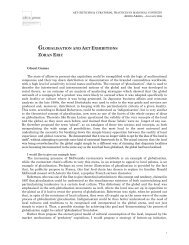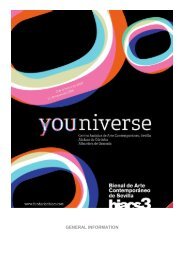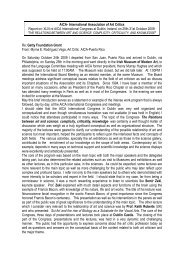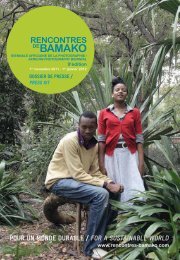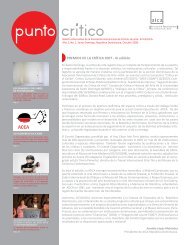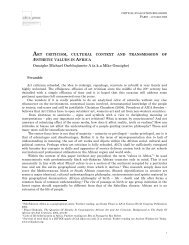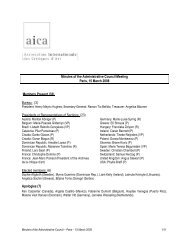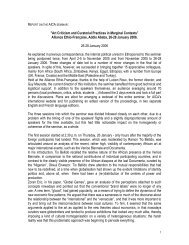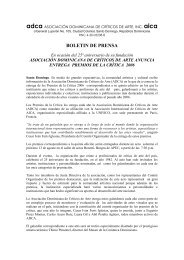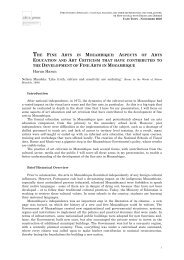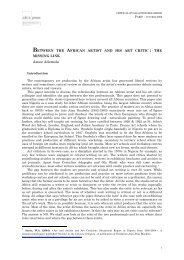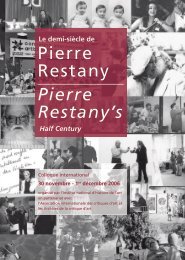BETWEEN THE PAST AND THE PRESENT ... - AICA international
BETWEEN THE PAST AND THE PRESENT ... - AICA international
BETWEEN THE PAST AND THE PRESENT ... - AICA international
You also want an ePaper? Increase the reach of your titles
YUMPU automatically turns print PDFs into web optimized ePapers that Google loves.
<strong>BETWEEN</strong> <strong>THE</strong> <strong>PAST</strong> <strong>AND</strong> <strong>THE</strong> <strong>PRESENT</strong>:<br />
DOES ART CRITICISM HAVE A FUTURE IN DE-TERRITORIALIZED CONTEXTS?<br />
29-30 September 2009, Erebuni Plaza Business Center, Yerevan, Armenia<br />
<strong>AICA</strong> seminar organized in Yerevan, Armenia in co-operation with <strong>AICA</strong>-Armenia<br />
THURSDAY 29 SEPTEMBER: EREBUNI CONFERENCE HALL- EREBUNI PLAZA BUSINESS CENTER<br />
09:30-10:00 Welcome speech and introduction<br />
Nazareth KAROYAN, President of <strong>AICA</strong> Armenia<br />
Hasmik POGHOSYAN, Minister of Culture of RA<br />
Christophe DOMINO, <strong>AICA</strong> delegate<br />
10:00-12:00 Strategies of Criticism: Ideology, Agency, Myth<br />
Moderator: Ekaterina DEGOT<br />
12:00- 12:30 Coffee Break<br />
Ramon Tio BELLIDO, Criticism between Ideology of Time and Ideology of Space<br />
Galit EILAT, What Can We Offer in the Place of Art Criticism?<br />
Ara NEDOLYAN, The Functions of Art Criticism and Their Possibilities in Society<br />
Chritsophe DOMINO, Myths and Survival of the Emancipatory Hypothesis<br />
Nazareth KAROYAN, Can Art Criticism be Constructive? - What Does It Mean?<br />
Small Discussion<br />
12:30-14:30 Critical Localities and Pedagogies<br />
Moderator: Vardan AZATYAN<br />
Hrach Bayadyan, The Premises and Obstacles of Critical Cultural Studies<br />
Tony Chakar, Art Criticism in Lebanon<br />
Deniz Erbaş, Art Writing Instead of Art Criticism<br />
Gamal Bokonbaev, Salvation of a Drowning Person<br />
Rouben Arevshatyan, Problems of Art Education in Armenia<br />
Small Discussion<br />
16:00-18:00 Critical Perspectives: History, Power, Contemporaneity<br />
Moderator: Christophe DOMINO<br />
Khatuna Khabuliani, New Functions for Art Criticism<br />
Vardan Azatyan, Towards A Critical History of Art Criticism<br />
Sohrab Mahdavi Ardebili, Does Art Criticism Have A Future in De-territorialized Contexts?<br />
Vardan Jaloyan, Art Criticism in Armenia after March 01, 2008<br />
Ekaterina Degot, Art Criticism and Its Perspectives (If It Has Any)<br />
Small Discussion
WEDNESDAY 30 SEPTEMBER: ARGISHTI CONFERENCE HALL- EREBUNI PLAZA BUSINESS CENTER<br />
10:00-12:00 General Discussions on the issues of Art Criticism in Region<br />
Participants<br />
Vahram AGHASYAN (Armenia), Vardan AZATYAN (Armenia), Ruben AREVSHATYAN<br />
(Armenia), Hrach BAYADYAN (Armenia), Ramon Tio BELLIDO (France), Gamal<br />
BOKONBAEV (Kyrgyzstan), Tony CHAKAR (Lebanon), Ekaterina DEGOT (Russia),<br />
Christophe DOMINO (France), Marta DZIEWANSKA (Poland), Galit EILAT (Israel), Deniz<br />
ERBAS (Turkey), Vardan JALOYAN (Armenia), Nazareth KAROYAN (Armenia), Khatuna<br />
KHABULIANI (Georgia), Eva KHACHATRYAN (Armenia), Misak KHOSTIKYAN (Armenia),<br />
Sohrab MAHDAVI (Iran), Johanna MYTKOVSKA (Poland), Ara NEDOLYAN (Armenia)<br />
ABSTRACTS <strong>AND</strong> SHORT BIOGRAPHY OF SPEACHERS<br />
Sohrab Mahdavi Ardebili, Does Art Criticism Have A Future in De-territorialized Contexts?<br />
To be able to see a work of art that by nature doesn't lend itself to easy classification, one must approach it from<br />
an angle. Criticism is that angle. It is a way to see a work. There are as many forms of criticisms as there are works<br />
of art; but depending on how one defines it, criticism -- as a literal exegesis of signs and symbols -- has always<br />
accompanied artistic practices and visa versa.<br />
Today in Iran, few, if any, are critics who reflect on the contemporary art scene as a professional undertaking.<br />
Critics belong by and large to the artistic community. The boom in the art market, especially over the past decade,<br />
has not had its corresponding effervescence in the critical sphere. Contemporary artists have had to bear the burden<br />
of reflecting on their own works, to make them accessible to their chosen public.<br />
The revolution of 1979 intensified parallel cultural tendencies that mirrored social divisions. The new social elite<br />
that emerged following the revolution did not supplant its pre-revolutionary, western-oriented counterparts. It brought<br />
its own ethos to bear. This in turn resulted in diverse and dynamic socio-cultural aesthetic preferences. With the<br />
reformist administration of Mohammad Khatami (1997-2005), the atmosphere of the country became more conducive<br />
to a dialogue between diverging and at times antagonistic socio-cultural spheres. But the tide was stemmed once the<br />
"value-oriented" Mahmood Ahmadinejad took office in 2005.<br />
The post-revolutionary penchant to meticulously guard public spaces has had many wanted and unwanted<br />
consequences. In the arts, any exhibitionism outside political mandates has been relegated to the private sphere. Art<br />
galleries, as intermediary spaces that must also abide by state prescribed guidelines, may challenge the state in their<br />
shows, but they do so with caution. As such, they walk on the border dividing the Public and Private.<br />
At the same time, and ironically, the showdown between distinct socio-cultural forces within the country has<br />
made non-establishment, western-informed artistic goods delicacies outside the country. In other words, what<br />
became "global" came directly from the extreme "local," or artistic niches that could seldom see the light of day.<br />
I propose that within Iran, art criticism is vital to the popularity of art as a form of social expression, to the comingout-of-isolation<br />
of private practices, and towards an understanding of what global tendencies may represent.<br />
Sohrab Mahdavi, born in Teheran, where he grew up, left the city after the Iranian Revolution of 1979 and spent the next<br />
eleven years in exile in the USA. He is graduated from University of Colorado (1986, Bachelor of Arts in Mathematics and<br />
Philosophy). Being one of Iran’s most prominent translators’ since 1999 he is cofounder and chief editor of the bilingual<br />
internet forum « TeheranAvenue ».<br />
Ruben Arevshatyan, Problems of Art Education in Armenia<br />
What is the situation with art education in Armenia in the context of progressing neoconservative trends in sociocultural<br />
conditions? How does the contemporary art scene here relate to the educational system? New educational<br />
institutions and experimental educational projects as practices of knowledge production. Fine Arts Department of<br />
Armenian Open University: “Changes through Exchanges” experimental educational project.<br />
<strong>BETWEEN</strong> <strong>THE</strong> <strong>PAST</strong> <strong>AND</strong> <strong>THE</strong> <strong>PRESENT</strong>: DOES ART CRITICISM HAVE A FUTURE IN DE-TERRITORIALIZED CONTEXTS?<br />
2
Ruben Arevshatyan is an artist, art critic, independent curator. Graduated from Yerevan Fine Arts and Theatrical Institute,<br />
department of sculpture. Teaches art history at the department of Fine Arts in the Armenian Open University. In the period of<br />
1997-2004 artistic director of Hay-Art cultural center, Yerevan. Author of numerous critical texts in local and <strong>international</strong><br />
magazines and publications. His critical articles concern the current problems of Armenian contemporary art, architecture, art<br />
theory and art education. Regional correspondent of Springerin art magazine since 1999. Curator and associate of local and<br />
<strong>international</strong> projects like “Great Atrophy”, “Parallel Reality”, “Three Tendencies”, “Adieu Parajanov”, “Local Modernities”,<br />
“Sweet 60s”, etc... Lives and works in Yerevan<br />
Vardan Azatyan, Towards A Critical History of Art Criticism<br />
Can there be such a thing as critical history of art criticism? If yes, will it be counted as art criticism, or will it be<br />
considered as art history? In my talk I will elaborate on some of the theoretical and methodological problems of<br />
interrelation between history and criticism and will conclude by touching upon the case of the project of writing a<br />
critical history of art criticism of Soviet Armenia, which is being developed in the pages of online art history journal<br />
Revisor.<br />
Vardan Azatyan, PhD, is an art historian and translator. He is a Professor in art history at Yerevan State Academy of Fine<br />
Arts. As a Visiting Professor he has lectured at Columbia University in the City of New York and Dutch Art Institute. He is<br />
cofounder and a vice-president of <strong>AICA</strong> – Armenia, as well as cofounding editor of online Armenian art history journal<br />
Revisor. His professional interests are focused on theories and methodologies of art history, as well as histories and theories<br />
of contemporary art. His translations include major works by George Berkeley and David Hume.<br />
Hrach Bayadyan, The Premises and Obstacles of Critical Cultural Studies<br />
The paper is comprised of two parts. The first will be an introduction dealing with the relation between<br />
intellectuals and power, the public sphere and so on. The second part considers the possibilities of cultural studies<br />
for the formation of post-Soviet studies. An important portion of the paper is related to the desire to outline a general<br />
post-Soviet cultural and cognitive context.<br />
Hrach Bayadyan is a cultural critic. He has written on post-Soviet/postcolonial relationship, on post-Soviet media, culture,<br />
and urban spaces, on social and cultural implications of information and communication technologies. He is a lecturer at<br />
Yerevan State University.<br />
Ramon Tio Bellido, Criticism between Ideology of Time and Ideology of Space: A Reconsideration of the<br />
Concept of Margins and Marginalities.<br />
The fundamental change that art knows today obliges us to completely reconsider the contexts and the pretexts<br />
of creation. For a long time, art has been taken in terms of an acting and prospective (both modern and avant-garde)<br />
marginality. Currently it is more the prerogative of territorial and cultural redistributions which modify the criteria of<br />
evaluation and their distribution in “rhizome” (the post-modern and globalization). A discussion on certain particular<br />
examples of creation will enable us to compare and evaluate the importance of this radical epistemological cut.<br />
Ramon Tio Bellido is an art critic, free lance exhibition curator and former General Secretary of <strong>AICA</strong>. He has been<br />
successively head of <strong>international</strong> policy of DAP, inspector for creation, artistic director of FNAGP at Hotel des Arts-Rue<br />
Berryer, director of the MST in exhibition organising and of the Gallery Art et Essai at the University of Rennes 2. He has<br />
written many books including L’Art et les Exposition en Espagne pendant le franquisme, L’art a toujours vingt ans, Histoire<br />
de 50 ans de l‘<strong>AICA</strong>, Le XX siècle dans l’art algérien, and Le XX siècle dans l’art polonais.<br />
Gamal Bokonbaev, Salvation of a Drowning Person<br />
Art History of Kyrgyz is now facing a need to comprehend the concept of the festival art. In this regard emerges a<br />
problem of an intrinsic context, the basics for the contribution of the regional and<br />
<strong>international</strong> context. Is it necessary? What kind should it be? In which fields is it possible? Is it possible to be<br />
satisfied with the achievements at the republican level? Is not it a movement backwards?<br />
Intercultural dialogue is in contrast to the pathos of national identity. The soviet background is the only centripetal<br />
force. In its absence, a regional “cold war” and coolness in politics are inevitable. Possibly, it is here that it is<br />
necessary to search for a new identity for countries in the region. In order to understand the post-soviet context it is<br />
necessary to review the history and meaning of the USSR culture. In this issue the following themes are of interest:<br />
The phenomenon of the closed system and discrediting of social art, Art Fetishization (cult of art), Soviet<br />
romanticism, sentimentalism and aestheticism, Formalism of the Soviet Art History.<br />
<strong>BETWEEN</strong> <strong>THE</strong> <strong>PAST</strong> <strong>AND</strong> <strong>THE</strong> <strong>PRESENT</strong>: DOES ART CRITICISM HAVE A FUTURE IN DE-TERRITORIALIZED CONTEXTS?<br />
3
Gamal Bokonbaev was born on November 26, 1958. In 1980 graduated Architectural faculty of the Polytechnic Institute in<br />
Bishkek. Since 1981 till 1985 worked as an architect. Since 1985 worked as a designer.<br />
Since 1996 – member of the Artists Union of the Kyrgyz Republic. Since 2001 has been engaged in art criticism. Participated<br />
in the numerous republican projects on creation of institutions of contemporary art and creation of periodicals on culture. In<br />
2005 worked as the assistant of the main editor of the almanac on culture of Central Asia «Kurak» (publisher: «Soros<br />
Foundation» – Kyrgyzstan). Since 2008 – main editor of a periodical «Rukopis»(«Manuscript») of the Artists Union.<br />
The largest curator projects and editions:In 2006 – editor-composer and author of the comments for the book «20-21. Fine<br />
art in Kyrgyzstan». 2006: «Chuikov and his Epoch». The exhibition and edition about development of the Soviet picturesque<br />
school in Kyrgyzstan. 2007: «Epoch». The exhibition and edition about visual culture during first fifteen years of<br />
independence. 2008: «Uch Emchek». The project of eight artists on contemporary art of Kyrgyzstan. The exhibition and<br />
edition.<br />
Tony Chakar, Art Criticism in Lebanon<br />
Art criticism in Lebanon has much to overcome: the dichotomy between politically engaged and non-engaged art,<br />
based on defunct 1970s nationalistic political theories; the poverty of the post-war social environment and social<br />
experiences; the ever-growing marginalization of all forms of art practices due to persistent political and economic<br />
instabilities in Lebanon and the region of the eastern Mediterranean, etc.<br />
But most of all, in the two decades that followed the official end of the Lebanese civil wars, mainstream art<br />
criticism has failed to recognize the contemporary art practices that came out of Beirut, not to mention the practices<br />
that live on the fringes of what is usually recognized as “art”. The lightness of the texts that were written about or<br />
around such practices is proof of the inability of such criticism to identify the pathos with which these practices are<br />
infused, even when the catastrophic experience of the civil wars is not directly mentioned. Would the recognition and<br />
identification of the catastrophes’ evanescent images be a way out of the deepening crisis in Lebanese culture in<br />
general and art criticism in particular?<br />
Tony Chakar is an architect and writer, born in Beirut in 1968. his works include: Four Cotton Underwear for Tony: Ashkal<br />
Alwan, TownHouse Gallery, Cairo, also part of Contemporary Arab Representations, a project curated by Catherine David<br />
(2001-02) and in the exhibition "Closer", Beirut Art Centre (2009); Beirut, the Impossible Portrait: The Venice Biennial (2003);<br />
The Eyeless Map: Ashkal Alwan, Beirut (2003); A Window to the World (2005): Ashkal Alwan, Beirut; Various Small Fires<br />
(2007): The Royal College of Art, London; Memorial to the Iraq War (2007): ICA, London; Yesterday's Man (2007): a playperformance<br />
with Rabih Mroué and Tiago Rodrigues; The Eighth Day (2008): Lecture/performance last shown NY, April<br />
2009. He also teaches History of Art and History of Architecture at the Académie Libanaise des Beaux arts (ALBA).<br />
Ekaterina Degot, Art Criticism and Its Perspectives (If It Has Any)<br />
In the art world, it is hardly customary for the artist who is “critical” himself (in relation to society, aesthetics, or “in<br />
general”) to hear that his newest painting is worse than his last. Art critics do not really criticize; they know that one<br />
hand washes the other, that they are working “for a common cause.” The critic is only a critic in the Kantian sense;<br />
he has not been criticizing professionally since the early 20 th century. This becomes especially apparent in<br />
comparison to film and theater criticism, which still lauds or berates directors and actors and offers its readership<br />
advice on which premieres to visit, seeing precisely this critical function as its calling. One generally assumes that<br />
this is because neither film nor theater are as advanced as “art,” where the audience’s reaction can already be safely<br />
ignored (since the number of visitors bears no direct relation on sales).<br />
Usually, this state of affairs is to the artist’s liking. One could say that the art world is sitting pretty. Recently,<br />
however, some artists have emerged (are they really still artists?) who see the fame of a Steven Spielberg as<br />
something seriously worth fighting for (much unlike Jeff Koons), and are ready to part with their psychological<br />
security in doing so, because after all, film critics will generally throw annihilating mockery in Spielberg’s direction<br />
(implying how sick we all are of him!), but they will do so on the front page.<br />
Ekaterina Degot is a PhD, art historian, art critic and curator based in Moscow. She has worked as a senior curator at the<br />
State Tretyakov Gallery, art columnist at Kommersant Daily and since 2008 is senior editor of www.openspace.ru/art , an<br />
independent site of art news, art criticism and cultural analysis. She has taught at the European University, St Petersburg,<br />
has been a guest professor at various American and European universities, and is currently professor at Moscow Alexander<br />
Rodchenko photography and new media school. In 2001, she curated Russian pavillion at the Venice Biennial. Shows she<br />
has curated or co-curated include: Body Memory: Underwear of the Soviet Era (City History Museum, St Petersburg, 2000);<br />
Moscow - Berlin 1950 – 2000 (Martin-Gropius-Bau, Berlin, and the History Museum, Moscow, 2003 -04); Soviet Idealism<br />
(Musee de l’art wallon, Liege, 2005), The Comedy: the Funny Side of a Moving Image (Central House of Artists, Moscow,<br />
2005), Tony Cragg (Central House of Artists, Moscow, 2006), Struggling for the Banner: Soviet Art Between Trotsky and<br />
Stalin (New Manege, Moscow, 2008), Citizens, Mind Yourselves: Dimitri Prigov (Museum of Modern Art, Moscow, 2008), and<br />
Kudymkar – Locomotive for the Future (Perm Art Museum, 2009). Her books include: Terroristic Naturalism (1998), Russian<br />
<strong>BETWEEN</strong> <strong>THE</strong> <strong>PAST</strong> <strong>AND</strong> <strong>THE</strong> <strong>PRESENT</strong>: DOES ART CRITICISM HAVE A FUTURE IN DE-TERRITORIALIZED CONTEXTS?<br />
4
20th-Century Art (2000) and Moscow Conceptualism (with Vadim Zakharov, 2005). In 1995, she received the “Courant d’Est”<br />
fellowship, Centre Pompidou, Paris, in 1998 she was a Fulbright scholar, in 1999 a Virginia Hanks Distinguished Visiting<br />
Curator, Duke University Museum of Art, in 2003 she received a fellowship at the Zentrum fuer Literaturforschung, Berlin, in<br />
2004 a “Post Communist Condition” fellowship at ZKM Karlsruhe and was a visiting curator at Jane Voorhoos Zimmerli<br />
Museum of Art, New Brunswick, NJ. She is member of many <strong>international</strong> jurys, including the Princess Margaret International<br />
Prize and others.<br />
Christophe Domino, Myths and Survival of the Emancipatory Hypothesis<br />
Modern ambition of emancipatory art largely nourishes art criticism’s emancipatory claim. Does this claim sound<br />
credible given a specific position of the statement that characterizes art criticism, i.e. its secondary status vis-à-vis art<br />
and its permanent indebtedness to the latter? In order to show this I will bring several examples and<br />
counterexamples from the context of contemporary criticism and its contrasting geography.<br />
Christophe Domino is free lance art critic, former president of <strong>AICA</strong> France. He has been contributing for some twenty years<br />
to collective works, monographic catalogues and specialist press. He has worked for a television and radio and is also<br />
exhibition curator. He has published around a dozen books and edited several more, including the monograph on Gilles<br />
Mahé(2004). He also has career in teaching, lecturing and research (museum and art centers, fine-art schools and<br />
universities).<br />
Galit Eilat, What Can We Offer in the Place of Art Criticism?<br />
How can art institutes, museums and cultural centers offer platforms on which to reflect and react to volatile<br />
conditions of culture and politics and produce a critical approach to oppressive powers? The talk will go beyond a<br />
critical reading to offer field strategies for practice.<br />
Galit Eilat is a writer, curator and the founding director of The Israeli Center for Digital Art, Holon. She is co-editor in chief of<br />
Maarav – an online arts and culture magazine. She curated and co-curated exhibitions: Chosen - A joint collaboration<br />
between Wyspa Institute of Art and The Israeli Center for Digital Art. 2008-2009 'Mobile Archive' in colaboration with<br />
Hamburg Kunstverein, WYSPA, Gdansk, Nova Gallery, Zagrab, Skuc Gallery, Ljubljana, Venice University, Venice,<br />
Newbery Gallery at the Glasgow School of Art, Glasgow. 2007-2008. 'Works in translation', and Hapzura Festival, co-curated<br />
with Eyal Danon The Israeli Center for Digital Art, Holon 2007. 'Liminal Spaces' traveling seminar, co-curated with Eyal<br />
Danon, Reem Fadda and Phil Misselwitz. Israel and Palestine 2006-2008. 'People, Land, State',.The Israeli Center for Digital<br />
Art, Holon 2006. 'This is not America'. By Art Project Gallery, Tel Aviv 2006. Her Texts (Books/Catalogues/Magazines)<br />
includes: 'Active Camera', Access to IsraelII, Jewish museum, Frankfurt 2008. Yael Bartana, Catalogue essay, CCA 2008.<br />
ArtPress no 342 , 'Multiple Cultures Is Not Multiculturalism' 2008. 'work in Translation' Exhibition Catalog 2007. Vector<br />
Magazine issu 3 , 'Forbidden Games' 2007. Avi Mograi, catalogue essay, Publisher Van Abbemuseum 2007. 'Margalit' Aya<br />
Ben Ron catalogue essay, Israel 2007. 'Hila Lulu Lin' catalogue essay, Museum Ein Harod, Israel 2007. 'People, Land,<br />
State', exhibition catalog, 2006. Yael Bartana, catalogue essay, Publisher Van Abbemuseum 2006. 'Lettre International 12'<br />
Kunst Skal Forstyrre, Denemark 2006.'Alternative Narratives' and 'Interview with Jack Parsekian' in City of Collision,<br />
Birkhauser – Publisher for Architecture, Basel, Boston, Berlin 2006.'Symptoms of the Present', Art, City and Politics in an<br />
expanding word, The 9 th istanbul biennial 2005.<br />
Deniz Erbaş, Art Writing Instead of Art Criticism<br />
My presentation will focus on the recent developments in the local art scene of Istanbul, with its network<br />
extensions, curatorial achievements and critical theory forums towards EU, South Caucasus and the Middle East.<br />
The actual situation and positioning of art criticism and its relations with the <strong>international</strong> one will be outlined in theory<br />
and practice, i.e. with examples of texts and art works. The past and current examples of the two general tendencies<br />
dominating and defining the general framework of the majority of art theory and practices are the art-history writing<br />
(positioning of the official and private institutions within the framework of classical art history perspectives and<br />
memory constructions) and the individual positioning (possibilities of dialogue in the current dynamics of the society<br />
and the art world, multidisciplinary approaches and connections with social sciences, politics and media, a general<br />
determination of broadening the limits and zone of influence of art practices, visibility in the independent art scene).<br />
In this paradigm, we are experiencing and suffering of the dictums of Modernism, lack of a tradition of post-colonial/<br />
post-modern art criticism. The influence of art criticism on the society and on the practicing actors of the art scene is<br />
replaced by a genre of art writing mostly represented by curators and artists themselves together with researchers<br />
and academicians, who are using the art discourses for their own statements. I will try to define the methods and<br />
ways of broadening the scope of art history and art criticism to a multi-disciplinary context and to the requirements of<br />
today’s art making and cultural industry, in our socio-political, geographical sphere.<br />
<strong>BETWEEN</strong> <strong>THE</strong> <strong>PAST</strong> <strong>AND</strong> <strong>THE</strong> <strong>PRESENT</strong>: DOES ART CRITICISM HAVE A FUTURE IN DE-TERRITORIALIZED CONTEXTS?<br />
5
Deniz ERBAŞ was born in İstanbul in 1978. After graduating from Art Management program of Yildiz Technical University,<br />
she worked as coordinator, editor and translator in several NGO’s such as IKSV, European Cultural Association and<br />
Documentary Filmmakers Association. She was one of the initiator and the general coordinator for the year 2007-2008 of<br />
Hafriyat Karakoy (artist run space). In the last two years she participated to <strong>international</strong> art events in Erlangen, Tbilisi,<br />
Nicosia, Berlin and Munich as curator or panellist and collaborated in and coordinated projects together with artist’s initiatives<br />
and groups. Since April 2008, she works as project coordinator in the Visual Arts Department of the Istanbul 2010 European<br />
Capital of Culture Agency.<br />
Vardan Jaloyan, Art Criticism in Armenia After March 01, 2008<br />
During the years of Gorbachev’s Perestroika, contemporary art coming out of underground became one of the<br />
bearers of Western knowledge in post-Soviet Armenia. It is not that the art represented by contemporary artists<br />
originated in the West or that it was developed by the support from the West. The question is not even in that their<br />
descriptions of local experiences were done within Western conceptual framework. The more important thing was<br />
West’s role as a locus of power without which it would have been impossible to reconstruct an art scene that made<br />
specific media and forms possible. If the “Soviet modernism” of 1960s legitimized itself through the national as its<br />
locus of power, the “Armenian avant-garde” being in sharp conflict with the former, found it in Western powerknowledge.<br />
On the other hand, the redistribution of property was crucial for the development of Armenian art,<br />
including contemporary art. Particularly, we can remember the case of the building of the Cultural Center “HayArt”<br />
which in the early years of Ter-Petrossian’s liberal regime was “offered” to the “avant-gardists,” and afterwards was<br />
taken away by the “nationalist” regime of Kocharyan.<br />
Armenian contemporary art was and largely is related to the part of Armenian elite which propagates<br />
“democracy”, “human rights” “market” and “economic liberalism,” thus involuntarily becoming one of the channels of<br />
circulation of transnational capital.<br />
In 2006 art historian Vardan Azatyan wrote, “Today in the context of the “capital” reconstruction of Yerevan which<br />
became possible due to the flow of trans-national capital, [Armenian contemporary art is facing] a vital need to<br />
redefine itself. This supposes a historically aware conceptual and practical clarification of both political-economic and<br />
artistic agendas of one’s own practice.” As in the majority of post-Soviet countries, the dominant political-economic<br />
mindset in Armenia was a theory of “transition” which had its parallel in both artistic and critical practices.<br />
The crisis of liberal ideology and neo-liberal politics in Armenia could be attributed to 2007. It also implied<br />
blurriness of the discourse of “Western orientation” in which the “right” and the “left” were indistinguishable. It<br />
triggered problems in contemporary art scene as well. The old institutions are in crisis, while the new ones emerge,<br />
the most significant among them being <strong>AICA</strong> - Armenia, Art Laboratory, etc. We witness the first steps of artistic<br />
social activism.<br />
The crisis culminated in the events of March 1 st of 2008 when at least ten peaceful demonstrators were killed. Art<br />
criticism, from being a practice of a good will, turned into an inevitable requirement. In contemporary Armenian art<br />
these changes can be termed as “art’s political turn.” All this requires “a clarification of both political-economic and<br />
artistic agendas”. The clarification at political-economic level implies a precise characterization of the newly formed<br />
system, while the artistic level implies developing the tools for interpreting emergent practices.<br />
Vardan Jaloyan (Born 1962) is literary and art critic, philosopher, and member of <strong>AICA</strong> Armenia. Graduated from the<br />
Moscow Physical-Technical Institute (1985) he was deputy editor (1997-99) of art magazine In-Vitro. Since 2007 he is<br />
member of editorial board Religion and Society magazine. In his numerous articles and essays published in various art<br />
books and catalogues he studies the role of the modernism and women’s art in the transformation of modern Armenian<br />
society, the history of Armenian nationalism, the issues of public space in urban transformations in Yerevan.<br />
Nazareth Karoyan, Can Art Criticism be Constructive? - What Does It Mean?<br />
The request for constructive criticism is usually articulated by a political power as an urge directed to its<br />
opponents. It seems that in this way power discourse tries to contain the radicality of oppositional ideological-political<br />
groups.<br />
The question - Can art criticism be constructive? – first of all refers to theoretical functions of art criticism. These<br />
functions are shaped in relation to aesthetics (norms, descriptive and interpretative functions, scientificity), ideology<br />
(values, morality, censorship) and other socio-political and philosophical disciplines. The discussion of the possibility<br />
of constructive function of criticism primarily has to do with the clarification of art criticism’s relation to artwork<br />
(interaction and transmission, circulation, anticipation).<br />
The request for constructive functions among Armenian critics emerged in post-Soviet context, in the framework<br />
of the development of market relations which came to replace the old commanding-administrative regime. Pushing<br />
the production of the subject to the fore, the newly emergent socio-political and artistic practices have promoted a<br />
general stream of privatization and disintegration. Constructivness itself, the gestures opposing this stream, the<br />
platforms and projects aimed at restoring professional, social and human relations (institutionalization of criticism, the<br />
<strong>BETWEEN</strong> <strong>THE</strong> <strong>PAST</strong> <strong>AND</strong> <strong>THE</strong> <strong>PRESENT</strong>: DOES ART CRITICISM HAVE A FUTURE IN DE-TERRITORIALIZED CONTEXTS?<br />
6
uilding of educational, research and archiving programs, etc.) by revealing the context-sensitive character of art<br />
criticism turned out to be its practical manifestations.<br />
Nazareth Karoyan is an art critic, free lance exhibition curator, president of <strong>AICA</strong> Armenia. Since the 1980s he has been<br />
active in developing the contemporary art scene in Armenia (cofounder of artistic movement 3 rd floor, of the first private art<br />
galleries Goyak, Ex-Voto and the art magazine In Vitro. He now spends his time organizing training courses in exhibition<br />
skills and art criticism. In his numerous essays, articles and lectures he looks at where the art system is heading and how it<br />
ties in with the sociopolitical context and the artistic issues involved in communication between post Soviet Armenia and<br />
Europe.<br />
Khatuna Khabuliani, New Functions for Art Criticism<br />
We have to participate in transformation processes of society, world system and culture.<br />
New realities we confront construct different conditions for relationships and research tasks.<br />
Ex-soviet and some other developing countries have the similar experiences on the one hand and very different<br />
local features on the other. The big <strong>international</strong> shows of visual art represent illustration of new dynamics - hybrids<br />
of western culture and that of the developing countries, or original designs from Asia, Africa, Australia, etc... Visual<br />
art itself has not been concentrated on esthetics from the start times of Modern art, and now it includes critical<br />
suggestions or research positions towards social and political conditions. Therefore, art criticism gains new functions,<br />
besides focusing on art forms, it even has to interpret artistic criticism on society – by means to translate abstractions<br />
into verbal statements...<br />
Khatuna Khabuliani (born 1965) lives and works in Tbilisi, Georgia. She is an art critic, curator, publicist and researcher. She<br />
is an author of various critical and analytical articles for different editions and now works on her PhD research –<br />
“Transformation of visual signs”. In 2009 she curates the Georgian participation at 53rd International Venice Biennale. From<br />
2001-2005 Khatuna Khabuliani worked at CCCD_Caucasian Center for Cultural Development as an editor and curator.<br />
CCCD (later MAF_Media ART Farm) in collaboration with different organizations and studios has organized <strong>international</strong> and<br />
local exhibitions: Appendix1 and Appendix2, Neo Geo, Arteria, etc; it also founded The Institute of Photography and New<br />
Media and Khatuna Khabuliani worked as a lecture of contemporary art history and co-organizer of the projects on<br />
contemporary photography. In 2001 she curates the Georgian part of the exhibition The Baw of Stability in St. Petersburg. In<br />
2005 she was an editor of ARTURI _ newspaper on contemporary art, collaborated as a free-lance writer with different<br />
magazines and newspapers: 24 hours, Alternative, Style, etc.. From 2005 till now she teaches in Tbilisi State Academy of Art<br />
the course of Contemporary art. In 2008 she worked as an editor of IMPRESS magazine of visual art and literature. In 2009<br />
she co-founded The Center of Contemporary Art and union “art &society”.<br />
Ara Nedolian, The Functions of Art Criticism and Their Possibilities in Society<br />
With its attempts to define the essence of art and the problem of figuration, art is a regular event:<br />
- The social character of art, the possibility of definition of the scientific - philosophical bases of art<br />
criticism.<br />
- The social need for art.<br />
- Criticism’s need for art.<br />
- Art’s need to have society.<br />
- Two perceptions of life: de-jure/de-facto.<br />
- The degree of the freedom in the world of laws and regulations exceeds the degree of the freedom in the<br />
phenomenal world.<br />
- In the world of phenomenons there is will, PR, Monopoly.<br />
- In the world of regulations there is consciousness, criticism and self-criticism as well as free competition.<br />
- It is better to pose questions without answers than answers without questions.<br />
- The factual absence of art/criticism/ and its theoretical justification.<br />
- The will to being of art /criticism/, to which this conference testifies and the necessity to revolutionize<br />
public mentality.<br />
Ara Nedolian is theatrical critic, publicist, brainstorming games technician, Graduated from Fine-Arts and theatrical Institute<br />
he worked at Art Institute of National Academy of Science, State Department of Special Programs, Supreme Council and<br />
National cinematheque He has public activity at experts groups Scientific Industrial Union, Civic Union, Union of Socialists<br />
Forces, Group of the research for Foreign Policy and Socialist’s Conference. He is cofounder of Magazine’s Gnosis and<br />
Artsiv (Eagle). He contributed at Weekly’s “Urartu” and “Panorama.am”.<br />
<strong>BETWEEN</strong> <strong>THE</strong> <strong>PAST</strong> <strong>AND</strong> <strong>THE</strong> <strong>PRESENT</strong>: DOES ART CRITICISM HAVE A FUTURE IN DE-TERRITORIALIZED CONTEXTS?<br />
7


